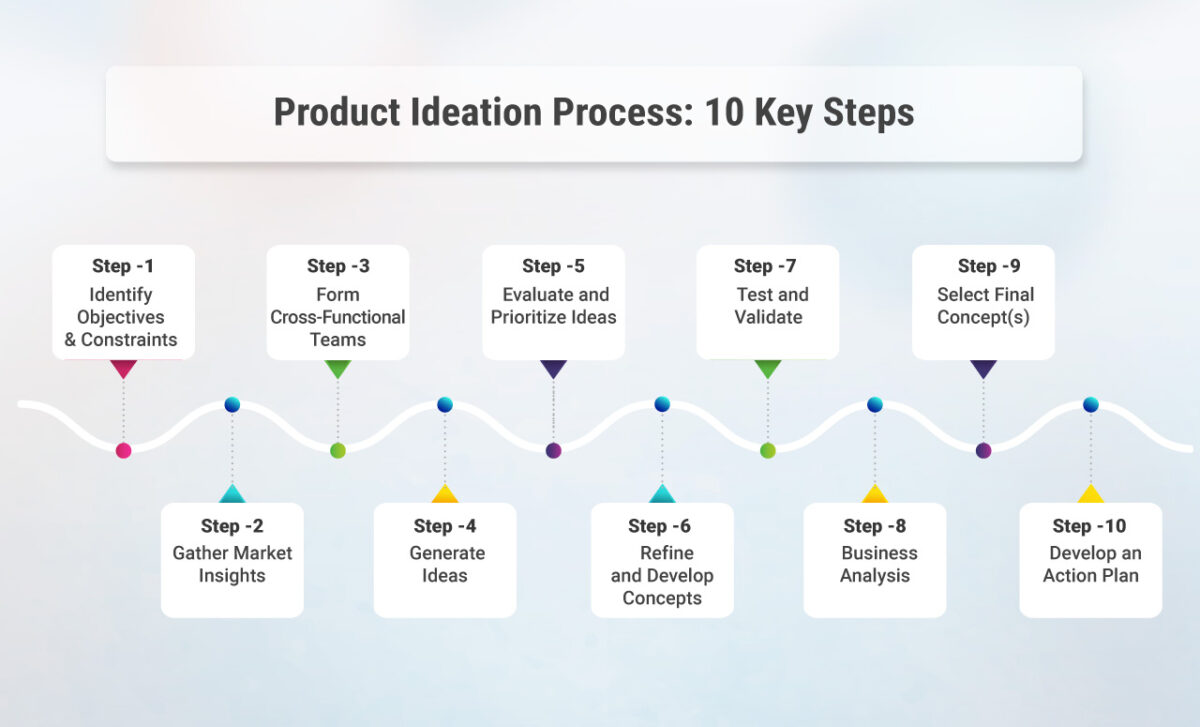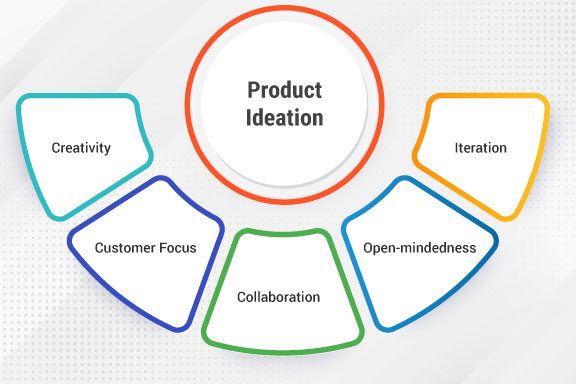What is Product Ideation?
Product ideation is defined as the process of generating, developing, and refining new product ideas with the aim of addressing customer needs, solving problems, or offering unique value propositions. It involves activities such as brainstorming, market research, trend analysis, and user feedback collection to generate a wide range of potential ideas. These ideas are then evaluated, prioritized, and refined into viable product concepts that can be further developed and brought to market.
Product ideation is a critical phase in the product development process as it lays the foundation for successful innovation. It encourages creativity, helps identify new market opportunities, and allows organizations to stay competitive by introducing new and improved products to the market.
Key Elements of Product Ideation
By considering the following key elements you can enhance your product ideation process and increase the likelihood of generating innovative and successful product ideas.
- Customer Focus: Product ideation should always be centered around understanding and meeting the needs of the target customers. By deeply understanding their pain points, desires, and preferences, you can create products that resonate with them and provide real value. Customer insights, customer feedback, and market research play a crucial role in guiding the ideation process and ensuring that the resulting ideas are customer-centric.
- Creativity: Creativity is essential for generating innovative and unique product ideas. It involves thinking outside the box, making unexpected connections, and coming up with novel solutions to address customer needs or solve problems. Creativity allows for the exploration of new possibilities and the generation of ideas that have the potential to disrupt the market or provide significant value.
- Open-mindedness: Open-mindedness is an important element of product ideation. It involves being receptive to ideation, perspectives, and feedback. Being open-minded allows you to consider a wide range of possibilities, even those that may initially seem unconventional or outside of your comfort zone. It encourages collaboration and fosters an environment where diverse ideas can be freely shared and explored.
- Collaboration: Product ideation often benefits from a collaborative approach, bringing together individuals from different disciplines and backgrounds. Collaborative ideation allows for the exchange of ideas, leveraging diverse expertise, and building on each other’s insights. It helps to broaden the scope of possibilities and encourages the generation of more comprehensive and innovative concepts.
- Iteration: Iteration is a crucial element of product ideation. The ideation process should involve multiple iterations and refinements of the initial ideas. Through prototyping, user testing, and gathering feedback, you can continuously iterate on the ideas, improving and refining them based on real-world insights. Iteration helps to validate assumptions, identify potential flaws or opportunities, and ensure that the resulting product concepts are robust and well-developed.
Learn more: What is Product Innovation?
Product Ideation Process: 10 Key Steps

The product ideation process typically consists of several key steps. While the specific approach may vary depending on the organization and context, here are the common steps involved in product ideation:
Step 1. Identify Objectives and Constraints
Clearly define the objectives of the product ideation process. Determine what you aim to achieve, whether it’s addressing a specific market need, improving an existing product, or exploring new opportunities. Additionally, consider any constraints or limitations, such as budget, resources, or technical feasibility, that may influence the ideation process.
Step 2. Gather Market Insights
Conduct thorough market research to gain a deep understanding of the target market, customer needs, and emerging trends. Analyze industry reports, consumer surveys, competitor products, and customer feedback to identify gaps and opportunities for innovation.
Step 3. Form Cross-Functional Teams
Assemble a diverse team of individuals with different perspectives and expertise. Include members from various departments, such as marketing, engineering, design, and sales. This multidisciplinary approach helps generate a wider range of ideas and ensures a holistic perspective during ideation.
Step 4. Generate Ideas
Conduct brainstorming sessions or idea-generation workshops with the cross-functional team. Encourage open and creative thinking, allowing participants to freely share their ideas. Utilize techniques like mind mapping, random stimuli, or role-playing exercises to stimulate idea generation. Aim for a high quantity of ideas initially, without too much concern for evaluation or feasibility.
Step 5. Evaluate and Prioritize Ideas
Once a pool of ideas has been generated, evaluate them based on predefined criteria such as market potential, feasibility, strategic fit, and competitive advantage. Use methods like scoring, ranking, or SWOT analysis to assess and compare the ideas. Narrow down the list to a set of high-potential ideas that align with the organization’s goals and resources.
Step 6. Refine and Develop Concepts
Take the selected ideas and develop them into more concrete product concepts. This involves conducting research, creating prototypes, and gathering customer feedback. Iterate on the concepts based on the insights gained during this process to refine and enhance their viability.
Step 7. Test and Validate
Test the refined concepts with target users or a representative sample of the target market. Collect feedback and assess how well the concepts address customer needs, meet expectations, and provide value. Use this feedback to further refine the concepts and make necessary iterations.
Step 8. Business Analysis
Perform a thorough business analysis of the refined concepts. Evaluate the potential market demand, competitive landscape, cost analysis, revenue projections, and return on investment. This analysis helps determine the feasibility and viability of the concepts from a business standpoint.
Step 9. Select Final Concept(s)
Based on the results of the business analysis, select the most promising concept(s) to move forward with the ideation process. Consider factors such as market demand, profitability, strategic fit, and resource requirements. It’s common to prioritize concepts and develop a roadmap for implementation.
Step 10. Develop an Action Plan
Create a detailed action plan outlining the necessary steps, timelines, and resources required to bring the selected concept(s) to fruition. This plan may include activities such as design, development, manufacturing, marketing, and launch preparations.
Learn more: What is Business Innovation?
Top 10 Best Practices for Product Ideation in 2023
By incorporating these best practices into your product ideation process, you can foster a more innovative and user-centric approach, leading to the development of successful and impactful products in 2023.
1. Embrace a User-Centric Approach: Put the user at the center of your ideation process. Understand their needs, pain points, and aspirations to create products that truly resonate with them.
2. Encourage Divergent Thinking: Encourage divergent thinking during brainstorming sessions. Create an atmosphere where wild ideas and unconventional thinking are welcome. Often, the most innovative solutions emerge from thinking outside the box.
3. Foster a Culture of Innovation: Encourage a culture that values and promotes innovation. Create an environment where employees feel empowered to share their ideas and experiment without fear of failure.
4. Emphasize Cross-Functional Collaboration: Bring together individuals from diverse backgrounds and expertise to foster collaboration and exchange of ideas. This multidisciplinary approach can lead to more holistic and innovative product concepts.
5. Incorporate Design Thinking: Apply design thinking principles to your ideation process. Empathize with users, define their problems, generate ideas, create prototypes, and iterate based on user feedback. This iterative approach can lead to user-centered and impactful product solutions.
6. Embrace Emerging Technologies: Stay abreast of emerging technologies and explore how they can be integrated into your product ideas. Technologies such as artificial intelligence, blockchain, Internet of Things (IoT), and augmented reality offer opportunities for innovation and differentiation.
7. Leverage Data and Analytics: Utilize market research, customer feedback, and data analytics to drive ideation. Gather insights from various sources to identify trends, customer preferences, and market gaps to inform your product ideas.
8. Iterate and Prototype: Embrace an iterative approach to ideation. Rapidly prototype and test your product ideas to gather feedback and validate assumptions. Use this feedback to refine and enhance your concepts before moving forward with development.
9. Encourage Continuous Learning: Promote a learning mindset within your team. Encourage them to stay updated on industry trends, emerging technologies, and customer behavior. This continuous learning will fuel ideation with fresh perspectives and innovative ideas.
10. Emphasize Sustainability and Social Responsibility: Consider sustainability and social responsibility in your product ideation. Explore ways to create environmentally friendly products, promote ethical practices, and contribute positively to society.
Learn more: What is Business Innovation?
Most Recent Blogs
Explore the latest innovation insights and trends with our recent blog posts.










